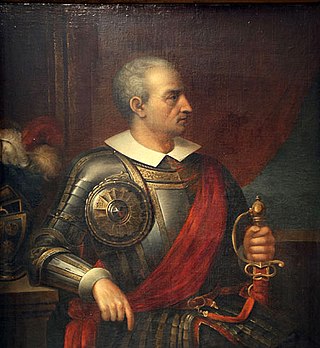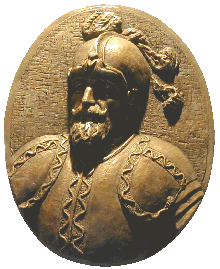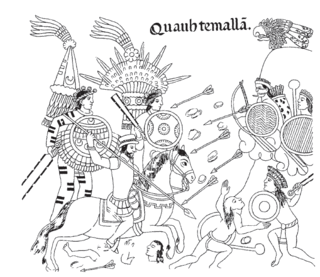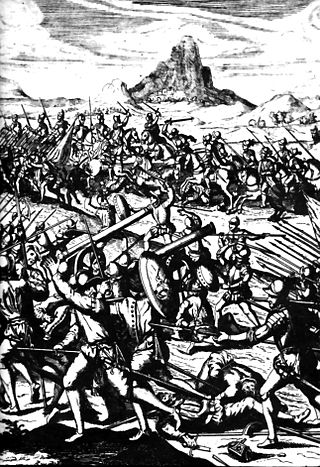
Diego de Almagro, also known as El Adelantado and El Viejo, was a Spanish conquistador known for his exploits in western South America. He participated with Francisco Pizarro in the Spanish conquest of Peru. While subduing the Inca Empire he laid the foundation for Quito and Trujillo as Spanish cities in present-day Ecuador and Peru respectively. From Peru, Almagro led the first Spanish military expedition to central Chile. Back in Peru, a longstanding conflict with Pizarro over the control of the former Inca capital of Cuzco erupted into a civil war between the two bands of conquistadores. In the battle of Las Salinas in 1538, Almagro was defeated by the Pizarro brothers and months later he was executed.

Pedro Gutiérrez de Valdivia or Valdiva was a Spanish conquistador and the first royal governor of Chile. After serving with the Spanish army in Italy and Flanders, he was sent to South America in 1534, where he served as lieutenant under Francisco Pizarro in Peru, acting as his second in command.

Pedro de Alvarado was a Spanish conquistador and governor of Guatemala. He participated in the conquest of Cuba, in Juan de Grijalva's exploration of the coasts of the Yucatán Peninsula and the Gulf of Mexico, and in the conquest of the Aztec Empire led by Hernán Cortés. He is considered the conquistador of much of Central America, including Guatemala, Honduras and El Salvador.

Gonzalo Pizarro y Alonso was a Spanish conquistador and younger paternal half-brother of Francisco Pizarro, the conqueror of the Inca Empire. Bastard son of Captain Gonzalo Pizarro y Rodríguez de Aguilar (senior) (1446–1522) who as colonel of infantry served in the Italian campaigns under Gonzalo Fernández de Córdoba, and in Navarre, with some distinction, and María Alonso, from Trujillo. He was the half brother of Francisco and Hernándo Pizarro and the full brother of Juan Pizarro.

In a protracted conflict during the Spanish colonization of the Americas, Spanish colonisers gradually incorporated the territory that became the modern country of Guatemala into the colonial Viceroyalty of New Spain. Before the conquest, this territory contained a number of competing Mesoamerican kingdoms, the majority of which were Maya. Many conquistadors viewed the Maya as "infidels" who needed to be forcefully converted and pacified, disregarding the achievements of their civilization. The first contact between the Maya and European explorers came in the early 16th century when a Spanish ship sailing from Panama to Santo Domingo was wrecked on the east coast of the Yucatán Peninsula in 1511. Several Spanish expeditions followed in 1517 and 1519, making landfall on various parts of the Yucatán coast. The Spanish conquest of the Maya was a prolonged affair; the Maya kingdoms resisted integration into the Spanish Empire with such tenacity that their defeat took almost two centuries.
The Battle of Las Salinas was a military conflict and decisive confrontation between the forces of Hernando and Gonzalo Pizarro against those of rival conquistador Diego de Almagro, on April 6, 1538, during the Conquest of Peru. Both camps claimed to represent the authority of the Spanish Crown; Pizarro's forces controlled the province of Nueva Castilla, and those of Almagro, Nueva Toledo.

Hernando Pizarro y de Vargas was a Spanish conquistador and one of the Pizarro brothers who ruled over Peru.

Alonso de Alvarado Montaya González de Cevallos y Miranda (1500–1556) was a Spanish conquistador and knight of the Order of Santiago.
Gonzalo de Alvarado y Contreras was a Spanish conquistador and brother of Pedro de Alvarado who participated in campaigns in Mexico, Guatemala, and El Salvador.
Jorge de Alvarado y Contreras was a Spanish conquistador, brother of the more famous Pedro de Alvarado.

Indian auxiliaries were those indigenous peoples of the Americas who allied with Spain and fought alongside the conquistadors during the Spanish colonization of the Americas. These auxiliaries acted as guides, translators and porters, and in these roles were also referred to as yanakuna, particularly during the Spanish conquest of the Inca Empire. The term was also used for formations composed of indigenous warriors which were used by the Spanish for reconnaissance and combat duties. Indian auxiliaries continued to be used by the Spanish to maintain control over their colonies in the Americas; frequently stationed on the frontier, they were often used to suppress anti-colonial revolts such as Arauco War.
Pedro Pizarro was a Spanish chronicler and conquistador. He took part in most events of the Spanish conquest of Peru and wrote an extensive chronicle of them under the title Relación del descubrimiento y conquista de los reinos del Perú, which he finished in 1571.

The Battle of Jaquijahuana was fought between the forces of Gonzalo Pizarro and Pedro de la Gasca, on April 9, 1548, during the Revolt of the Encomenderos by the Spanish conquistadores.

After the assassination of Francisco Pizarro, in retaliation for his father's execution in 1538, Diego de Almagro II, El Mozo, continued to press claims as the rightful ruler of Peru and as leader of his father's supporters. His claims were largely unsuccessful, however, as Pizarro was succeeded as governor by Cristóbal Vaca de Castro, despite claims from his brother Gonzalo Pizarro, whose claims to join arms against the Almagristas and "El Mozo" largely remained unanswered.

Pedro de Candia was a Greek explorer and cartographer at the service of the Kingdom of Spain, an officer of the Royal Spanish Navy that under the Spanish Crown became a Conquistador, Grandee of Spain, Commander of the Royal Spanish Fleet of the Southern Sea, Colonial Ordinance of Cusco, and then Mayor of Lima between 1534 and 1535. Specialized in the use of firearms and artillery, he was one of the earliers explorers of Panama and the Pacific coastline of Colombia, and finally participated in the conquest of Peru. He was killed in the Battle of Chupas, (Peru), on 16 September 1542, by Diego de Almagro II.

The Spanish conquest of the Maya was a protracted conflict during the Spanish colonisation of the Americas, in which the Spanish conquistadores and their allies gradually incorporated the territory of the Late Postclassic Maya states and polities into the colonial Viceroyalty of New Spain. The Maya occupied the Maya Region, an area that is now part of the modern countries of Mexico, Guatemala, Belize, Honduras and El Salvador; the conquest began in the early 16th century and is generally considered to have ended in 1697.
The Battle of Abancay was a battle that took place during the Spanish conquest of Peru. Alonso de Alvarado, sent by Francisco Pizarro to relieve the siege of Cusco, was camped at Jauja with five hundred men. He guarded the bridge and a ford on the Rio de Abancay, awaiting Almagro's men. However, the soldier Alvarado placed in command of the ford, Pedro de Lerma, deserted, allowing Almagro to capture Alvarado's force almost intact.

Diego de Holguín was a Spanish conquistador and the first mayor of San Salvador, serving from 1525 to 1528. He participated in the conquest of many nations in the Caribbean islands, Central America and Mexico, where he became famous for his courage.

The Spanish conquest of El Salvador was the campaign undertaken by the Spanish conquistadores against the Late Postclassic Mesoamerican polities in the territory that is now incorporated into the modern Central American country of El Salvador. El Salvador is the smallest country in Central America, and is dominated by two mountain ranges running east–west. Its climate is tropical, and the year is divided into wet and dry seasons. Before the conquest the country formed a part of the Mesoamerican cultural region, and was inhabited by a number of indigenous peoples, including the Pipil, the Lenca, the Xinca, and Maya. Native weaponry consisted of spears, bows and arrows, and wooden swords with inset stone blades; they wore padded cotton armour.













